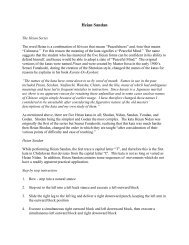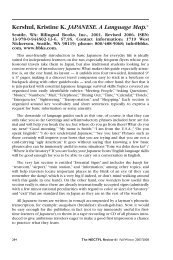selected paintings - Dickinson College
selected paintings - Dickinson College
selected paintings - Dickinson College
You also want an ePaper? Increase the reach of your titles
YUMPU automatically turns print PDFs into web optimized ePapers that Google loves.
17<br />
Firenze, Strade sotto Villa Mercede, Voltato L’Angolo,<br />
c. 1942<br />
Oil on canvas, 24 1/4 x 16 1/4 in. (61.6 x 41.3 cm)<br />
Signed and inscribed: l.l.: Quincy; c.l.b: FIRENZE/STRADE SOTTO VILLA<br />
MERCEDE, VOLTATO L’ANGOLO<br />
Exhibited: Spirit of the Past: The Paintings of Edmund Quincy, 1903-1997 (New<br />
York: Hirschl & Adler Galleries, 2000).<br />
Published: Zachary D. Ross, Spirit of the Past: The Paintings of Edmund Quincy,<br />
1903-1997 exh. cat. (New York: Hirschl & Adler Galleries, 2000), 38,<br />
cat. 44.<br />
Courtesy of Hirschl & Adler Galleries, NYC<br />
It is probable that Quincy created Firenze, Strade sotto Villa<br />
Mercede, Voltato L’Angolo with his other Italian <strong>paintings</strong>,<br />
including Venice Canal, in the early 1940s. It was after that trip<br />
that he began to exhibit his Italian <strong>paintings</strong>. 1 Quincy admitted<br />
to revising some of the titles of his works for his exhibition at<br />
Wellesley <strong>College</strong> in 1945. Therefore, it is possible Firenze,<br />
Strade sotto Villa Mercede, Voltato L’Angolo may have been exhibited<br />
under a different title in the Wellesley exhibition. 2<br />
Quincy <strong>selected</strong> a scene that is identifiable as Italy primarily<br />
from the cypress and olive trees scattered in the landscape. The<br />
image is set in the outskirts of Florence, perhaps in the<br />
Belvedere area. Quincy captured a side of Florence that is quieter<br />
and more removed from the central urban areas.<br />
Firenze, Strade sotto Villa Mercede, Voltato L’Angolo shows<br />
how Quincy manipulated his palette to find the “character” of<br />
the location he was painting. Quincy often tailored his color<br />
choices to reveal his perception of the location. In this painting,<br />
Quincy captured a clear day in Tuscany as the daytime light<br />
subtly washed over the scene. In a few of his other works, like<br />
Venice Canal and A Mediterranean Church, he used brighter,<br />
dramatically different colors. Quincy painted with a soft and<br />
tonal palette in Firenze, Strade sotto Villa Mercede, Voltato<br />
L’Angolo and excluded many contrasting colors. Instead, in his<br />
color selections, he included variations of the violet hue for<br />
many of the undertones and highlights. Quincy’s obvious application<br />
of violet and tonal colors can also be related to a few of<br />
Monet’s works that were done as studies of light throughout the<br />
day, such as the Rouen Cathedral and Haystacks series. 3 Monet<br />
dramatically showed the function of light on one subject at various<br />
times throughout the day. Therefore, it is not surprising<br />
that the color range Quincy used appears to be more limited,<br />
which is probably due to the time of day he is depicting. In<br />
addition, the paint is densely layered onto the surface which can<br />
also be related to “impressionist” techniques of using thick layers<br />
of paint.<br />
Quincy carefully intertwined cityscape and landscape to<br />
create balance and depth in his composition. A figure looks out<br />
onto the scene as a row of trees recedes back into a landscape<br />
with buildings scattered and layered into it. The buildings are<br />
each shown at an angle that creates diagonals and depth. These<br />
46<br />
diagonals lead the viewer into the background and back to the<br />
foreground. The composition works in a circular way with the<br />
buildings and landscape responding to the figure in the foreground,<br />
allowing the viewer’s eye to move through the work<br />
over and over again. The depth created in the composition acts<br />
as a conversation between the figure and the cityscape. The relationship<br />
of the figure to the rest of the setting gives the painting<br />
a tranquil and reflective quality as the figure is alone, gazing out<br />
onto the Tuscan scene.<br />
The figure seems paused in a moment that does not give<br />
this painting the same kind of bustling effect that is more obvious<br />
in some of Quincy’s other works like Street Scene, Boston,<br />
where figures are shown in motion. Quincy did a number of his<br />
works in industrialized and populated New England and<br />
European areas. These regions were more developed and indicative<br />
of an active urban culture. Through placing the figure<br />
paused in a serene setting, this painting reveals the slower pace<br />
of life in this region outside of the central parts of the city.<br />
Quincy took a “voyeuristic” approach in looking onto a<br />
quiet moment of a solitary man as he gazes onto the landscape.<br />
Quincy was positioned behind the figure and painted while the<br />
figure may have been unaware of his presence. The way in<br />
which Quincy framed the composition suggests he was interfering<br />
with the figure’s solitary moment.<br />
Quincy painted the figure fairly close-up and only included<br />
the one person. The figure is awkwardly positioned in the foreground.<br />
The way in which Quincy painted the figure is not as<br />
strong, technically, as the rest of the work. Quincy invites us in<br />
to share the same view as the man, but the figure is unbelievable,<br />
visually, which prevents the viewer from comfortably connecting<br />
to the human aspect of the scene. Even if the figure was<br />
not intended to be a focal point, it is so undeveloped that it<br />
becomes the primary visual focus and consequently, the figure<br />
acts as a curious juxtaposition to the rest of the composition.<br />
Quincy created this work in the middle of his career after he<br />
had years of experience with the figure. By the 1940s, Quincy<br />
already successfully completed a number of <strong>paintings</strong>, including<br />
figural depictions and even portraits. 4 In 1927, he studied in<br />
Paris under Georges-Leo Degorce who was known for landscapes<br />
and the nude. After he returned to Boston later that year,<br />
Quincy continued to work on his own landscapes, still life, and<br />
nudes. 5 Therefore, it is difficult to understand why Quincy<br />
shows the figure in such a nondescript manner.<br />
Quincy did not always include many figures in his <strong>paintings</strong>.<br />
However, he always suggested a human mark on a landscape<br />
or cityscape. In his painting of the Haystacks, Giverny, he<br />
depicted the hay bundled up for the harvest which shows that<br />
the landscape had been touched by people. 6 Figures, however,<br />
are not necessarily what Quincy tried to capture but rather, the<br />
atmosphere of a specific location. On the other hand, Quincy’s<br />
consistent effort to include figures helps the viewer to connect<br />
to the setting. In Firenze, Strade sotto Villa Mercede, Voltato






